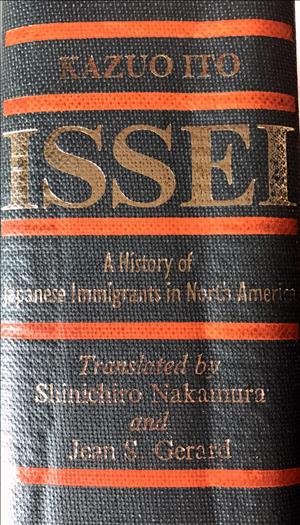On July 20, 1970, Japanese journalist Kazuo Ito (1924-2001) begins a weeklong visit to the Pacific Northwest for a series of book-publication parties hosted by Japanese Americans in five Northwest cities. He is visiting to celebrate the Japanese publication of his book Hyakunen sakura ("Hundred-year-old Cherry Blossoms"), which three years later will be translated into English as Issei: A History of Japanese Immigrants in North America. The book is an epic thousand-page compilation of maps, photos, poetry, and oral histories of the Issei, or first-generation Japanese immigrants to the United States. More than 40 years after its publication and translation, Ito's book will remain one of the few print compilations in English of primary-source material from the Issei about their lives in prewar North America.
Origins and Contents of the Book
A full-time journalist for the Yomiuri Shimbun in Tokyo, Ito worked for five years on the book in his spare time. Having been born in Hokkaido, an island with many immigrants from the main island of Japan, he began the project with a deep interest in knowing more about the Japanese immigrants who traveled to the United States. With the encouragement and initial assistance of Japanese American friends that he met in Tokyo, he began to research the project. Japanese American leaders and communities began to send him materials. Ultimately, sponsoring committees from Seattle and Portland wrote to him and told him that they had found a way to collect funds for the publication of his book.
Issei contained a wealth of material about Issei life in the United States prior to World War II. Ito had a large number of correspondents in Northwest cities who sent him material, including Japanese poetry, diaries, and memoirs of the Issei. The book also contained a large number of photographs, many also sent by his correspondents. Ito was also able to meet and interview Issei who traveled to Japan. In the epilogue to the Japanese edition, Ito estimated that more than 700 people had contributed to the book, with either financial or research assistance. The status of these papers remains in some dispute, as many documents remained with Ito and appear to have been donated as part of his estate to the Japanese Overseas Immigration Museum in Yokohama, Japan.
Though Ito's book pays tribute to Nisei (second-generation Japanese American) U.S. soldiers who died during World War II, it is remarkably reticent about the mass wartime incarceration of Japanese Americans. At the time of Ito's writing, the majority of Issei did not want to speak about their time in camp, which was traumatizing for many; preferring to remain silent about this experience. However, it is unclear if Ito did receive some material about the camps from the Issei and decided to omit this material altogether from the finished book.
Visiting Northwest Japantowns
Over the course of Ito's July 1970 visit to the Northwest, Japanese associations in Seattle, Portland, Yakima, Spokane, and Tacoma held parties in his honor to thank him for his efforts. Japanese American community leaders, newspaper publishers, ministers, and consular officials attended these banquets and gave speeches. The Seattle banquet included 300 Issei and Nisei who had helped with the publication of the book. In several locations, including Yakima and Spokane, Ito visited the graves of Japanese pioneers.
Ito was also able to visit several Northwest Japantowns, including those in Tacoma, Portland, Spokane, and Seattle. Although the visits were celebratory, several were also tinged with a deep melancholy. "Never again would Japanese Town revive" in Portland, he mourned. And in Tacoma, he wrote, "[in] this district I could no longer see many Japanese. The people have left and the street will one day disappear. With strong parting regrets, as long as time allowed I walked around, the shutter of my camera clicking" (Ito, 977). In particular, much of Tacoma's former Japantown was said to be slated for demolition for "urban renewal."
Ito hoped that his work would contribute to building international understanding between Japan and the United States, with a hope for mutual peace. At the end of the book tour, he met with the book's Executive Committee and reported the enthusiastic response and requests for an English translation of the book. He had heard from many around the Northwest that they wanted "Nisei and Sansei who cannot read Japanese to read pioneer Issei's living records telling of how they fought through the storm of exclusion and rooted in the great land of North America" (Ito, 977). The English version was published in 1973, translated by Shinichiro Nakamura and Jean Gerard as Issei: A History of Japanese Immigrants in North America. As of 2016, the book is out of print.

